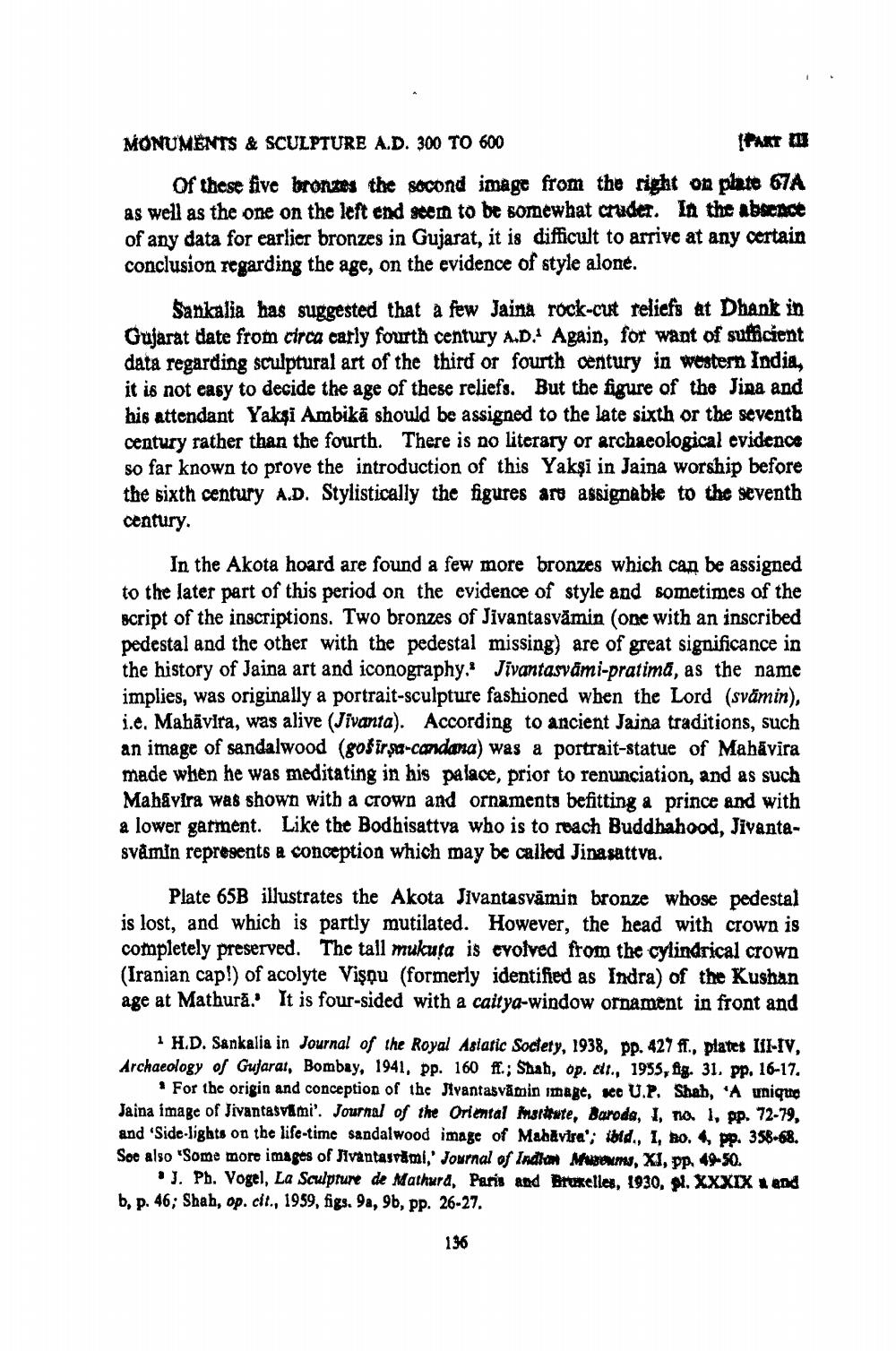________________
MONUMENTS & SCULPTURE A.D. 300 TO 600
PART Of these five bronzes the second image from the right on plate 67A as well as the one on the left end seem to be somewhat cruder. In the absence of any data for earlier bronzes in Gujarat, it is difficult to arrive at any certain conclusion regarding the age, on the evidence of style alone.
Sankalia has suggested that a few Jaina rock-cut reliefs at Dhank in ujarat date from circa early fourth century A.D. Again, for want of sufficient data regarding sculptural art of the third or fourth century in western India. it is not easy to decide the age of these reliefs. But the figure of the Jina and his attendant Yakşi Ambikā should be assigned to the late sixth or the seventh century rather than the fourth. There is no literary or archaeological evidence so far known to prove the introduction of this Yakşi in Jaina worship before the sixth century A.D. Stylistically the figures are assignable to the seventh century.
In the Akota hoard are found a few more bronzes which can be assigned to the later part of this period on the evidence of style and sometimes of the script of the inscriptions. Two bronzes of Jivantasvämin (one with an inscribed pedestal and the other with the pedestal missing) are of great significance in the history of Jaina art and iconography. Jivantasvāmi-pratima, as the name implies, was originally a portrait-sculpture fashioned when the Lord (svämin), i.e. Mahāvira, was alive (Jivanta). According to ancient Jaina traditions, such an image of sandalwood (goširşa-candana) was a portrait-statue of Mahāvira made when he was meditating in his palace, prior to renunciation, and as such Mahavira was shown with a crown and ornaments befitting a prince and with a lower garment. Like the Bodhisattva who is to reach Buddhahood, Jivantasvåmin represents a conception which may be called Jinasattva.
Plate 65B illustrates the Akota Jivantasvāmin bronze whose pedestal is lost, and which is partly mutilated. However, the head with a completely preserved. The tall mukuta is cvolved from the cylindrical crown (Iranian cap!) of acolyte Vişnu (formerly identified as Indra) of the Kushan age at Mathură.' It is four-sided with a caitya-window ornament in front and
1 H.D. Sankalia in Journal of the Royal Asiatic Society, 1938, pp. 427 ff., plates III-IV, Archaeology of Gujarat, Bombay, 1941, pp. 160 ff.; Shah, op. cit., 1955, fig. 31. pp. 16-17.
* For the origin and conception of the Stvantasvāmin image, so U.P. Shah, 'A unique Jaina image of Jivantasvami'. Journal of the Oriental insitute, Baroda, I, no. 1, pp. 72-79, and "Side-lights on the life-time sandalwood image of Mahavira'; d., I, bo. 4, pp. 358-68. Soe also "Some more images of Jivantasvami,' Journal of Indian Museums, XI, pp. 49-50.
J. Pb. Vogel, La Sculpture de Mathurd, Paris and Bruxelles, 1930, 91. XXXIX 1 and b. p. 46; Shah, op. cit., 1959, figs. 9a, 96, pp. 26-27.
136




